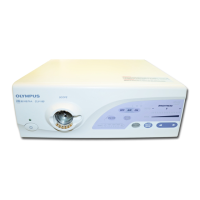
Do you have a question about the Olympus EVIS EXERA CLV-160 and is the answer not in the manual?
| Brand | Olympus |
|---|---|
| Model | EVIS EXERA CLV-160 |
| Category | Portable Generator |
| Language | English |
Identifies safety-related labels and symbols located on the rear panel of the light source.
Describes labels found on the back cover of the instruction manual, such as manufacturer and representative.
Specifies the intended use of the light source with Olympus endoscopes and ancillary equipment.
Explains the importance of reviewing the manual and keeping it accessible for safe operation.
Outlines the required qualifications for the operator of the light source.
Advises checking compatibility with ancillary equipment to prevent damage or injury.
States that only authorized parts can be replaced and advises against disassembly or modification.
Defines the signal words (DANGER, WARNING, CAUTION, NOTE) used in the manual.
Provides critical safety information regarding electrical hazards and application to the heart.
Details crucial safety measures, including electrical shock prevention and handling hot components.
Highlights precautions related to portable electronic devices and handling switches.
Instructs to match all items against the provided components and inspect for damage.
Details the components and functions of the front panel of the light source.
Describes the connectors and features found on the rear and side panels of the unit.
Provides guidelines for safely installing the light source, including placement and ventilation.
Details the steps for installing the light source on a mobile workstation using foot holders.
Explains how to connect the light source to the EVIS EXERA or EVIS video system center.
Provides instructions and warnings for connecting the endoscope's light guide connector.
Describes how to connect the light source to an OES video system.
Details the procedure for installing the water container on the light source.
Outlines the safety precautions and steps for connecting the light source to the AC power supply.
Checks the power indicator and fuses for proper operation and fault diagnosis.
Explains how to check the lamp life indicator and when to replace the examination lamp.
Details the steps to confirm the correct operation of the filter mechanism.
Describes procedures to inspect the air and water feeding functions via airflow indicators.
Verifies the emission of white examination light from the endoscope.
Inspects the safety feature that reduces light when no endoscope is connected.
Confirms the transillumination function for external endoscope position verification.
Assesses the functionality of automatic and manual brightness controls.
Provides essential warnings and precautions for safe operation of the light source.
Details the procedure for turning on the examination lamp.
Explains how to adjust the light intensity using automatic or manual controls.
Describes how to use the filter function for special applications.
Explains how to use the transillumination function to confirm endoscope position.
Details how to adjust the air pressure for feeding air or water.
Provides instructions on how to properly turn off the light source.
Explains how to monitor the examination lamp's lifespan and when replacement is needed.
Provides detailed, step-by-step instructions for safely replacing the examination (xenon) lamp.
Details how to clean the light source, including safety precautions and compatible cleaning agents.
Provides instructions on storing the light source in a suitable environment to prevent damage.
Advises following regulations for the disposal of the equipment and its components.
Lists common irregularities, their possible causes, and solutions for troubleshooting.
Provides instructions on contacting Olympus for repairs and necessary documentation.
Lists recommended combinations of equipment and accessories for the light source.
Details the ambient temperature, humidity, and air pressure requirements for operation.
Specifies the conditions for transporting and storing the equipment.
Lists detailed technical specifications of the light source, including power, size, and illumination.
Provides information on EMC compliance, electrical shock protection, and explosion protection.